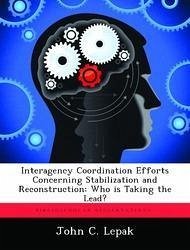Nicht lieferbar

Interagency Coordination Efforts Concerning Stabilization and Reconstruction: Who Is Taking the Lead?
Versandkostenfrei!
Nicht lieferbar
In May 2005, President Bush signed into effect National Security Presidential Directive (NSPD) 44, Management of Interagency Efforts Concerning Reconstruction and Stabilization, in an attempt to promote increased interagency coordination and planning. This policy directs the Department of State (DoS) to ?coordinate and lead integrated United States Government efforts, involving all U.S. Departments and Agencies with relevant capabilities, to prepare, plan for, and conduct stabilization and reconstruction activities as lead agency for stabilization and reconstruction efforts.? (Bush 2005) While...
In May 2005, President Bush signed into effect National Security Presidential Directive (NSPD) 44, Management of Interagency Efforts Concerning Reconstruction and Stabilization, in an attempt to promote increased interagency coordination and planning. This policy directs the Department of State (DoS) to ?coordinate and lead integrated United States Government efforts, involving all U.S. Departments and Agencies with relevant capabilities, to prepare, plan for, and conduct stabilization and reconstruction activities as lead agency for stabilization and reconstruction efforts.? (Bush 2005) While this directive is intended to promote coordination among United States Government (USG) Agencies and non-governmental organizations (NGOs), it does not lay out an effective framework for interagency coordination. In the approximate four years since NSPD 44 was released, Congress has not fully funded DoS stabilization and reconstruction initiatives and subsequently continues to fund existing Department of Defense (DoD) programs. This thesis examines funding of stabilization and reconstruction programs within DoS and DoD, as well as the types of interagency missions conducted at USSOUTHCOM since the release of NSPD 44. This work has been selected by scholars as being culturally important, and is part of the knowledge base of civilization as we know it. This work was reproduced from the original artifact, and remains as true to the original work as possible. Therefore, you will see the original copyright references, library stamps (as most of these works have been housed in our most important libraries around the world), and other notations in the work. This work is in the public domain in the United States of America, and possibly other nations. Within the United States, you may freely copy and distribute this work, as no entity (individual or corporate) has a copyright on the body of the work. As a reproduction of a historical artifact, this work may contain missing or blurred pages, poor pictures, errant marks, etc. Scholars believe, and we concur, that this work is important enough to be preserved, reproduced, and made generally available to the public. We appreciate your support of the preservation process, and thank you for being an important part of keeping this knowledge alive and relevant.








